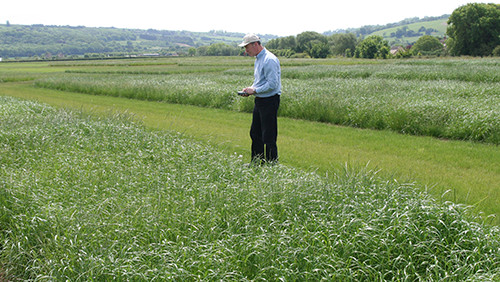Get more from your grassland with top-performing mixtures
For every farm, there is a ForageMax® grass seed mixture in the DLF portfolio that suits your needs. We report on new mixtures that: (1) increase year-two dry-matter yields by 3,3 tonnes per hectare; (2) boost milk production; and (3) improve farm self-sufficiency.
20/01/2016
Trials show how to increase yields from your grassland
We report on three sets of trials that produced higher yields for different grass-growing objectives.

Top dry-matter yields
Recent trials showed how combining Italian ryegrass with other species produces better yields of dry matter than you get from Italian ryegrass on its own. Our mixture produced an extra 2 tonnes (13% increase) of dry matter per hectare in year one and an extra 3.3 tonnes (25% increase) in year two.
This impressive result came from a combination of 30% Italian ryegrass with 60% Festulolium and 10% red clover. The improvement comes because the components of the mixture perform differently. Italian ryegrass yields well in the first year, whereas festulolium peaks in year two. Red clover also helps boost the yield by improving stability and drought tolerance, and adding protein to the mixture.
The optimal combination yielded 17 tonnes of dry matter per hectare at our research station in the Netherlands. This is similar to the yield of local maize, except that grass contains considerably more protein than maize. That is why it makes sense to feed grass or clover-grass to your cattle.
Relative yields of dry matter: 100 = 15,0 tonnes in first year and 13,3 tonnes in second year.
Boost milk production with clover and Festulolium
Since protein is vital for milk production, we have developed new ForageMax® mixtures that improve protein supply. For several years we have been comparing dozens of grass-clover mixtures at our four main testing sites in Europe, located in France, the Netherlands, UK, and Denmark.
Protein from red and white clover |
||||
|
|
Yield of dry matter, relative |
% protein in crop, average, all cut |
Kg protein per ha, all cut, two years |
Kg protein per ha, relative |
|
100% Festulolium PERSEUS* |
100 |
16,9 |
3175 |
100 |
|
80% Festulolium PERSEUS* + 20% red clover SUEZ |
97 |
18,3 |
3306 |
104 |
|
80% Festulolium PERSEUS* + 10% red clover SUEZ + 10% white clover KLONDIKE |
112 |
17,8 |
3925 |
124 |
|
|
|
|
|
|
|
100% Festulolium HYKOR** |
100 |
15,2 |
2995 |
100 |
|
80% Festulolium HYKOR** + 20% red clover SUEZ |
115 |
18,7 |
4091 |
137 |
|
80% Festulolium HYKOR** + 10% red clover SUEZ + 10% white clover KLONDIKE |
119 |
18,2 |
4252 |
142 |
|
*Type ryegrass ** Type tall fescue |
||||
Yield of dry matter and protein, total for first and second years. Development trials conducted by DLF
Be more self-sufficient with ForageMax® mixtures
The best way to beat the high prices of protein feeds and nitrogen fertilisers is to be more self-sufficient – to produce as much feed as you can on your own farm. If you're looking to improve beef and dairy-farm profitability by growing clover-grass, the combination of clover and Festulolium is outstanding.
With clover and Festulolium you win in two ways. The combination yields more than 2 tonnes of protein per hectare – enough to replace the same amount of soya protein bought at volatile market prices. And it feeds as much as 250kg of nitrogen into each hectare of your sward, free of charge – much better than buying in nitrogen by the bagful.
Clover and Festulolium are good in many ways:
- Increases the feed intake of your herd – by 10% to 20% for grazing and for silage.
- Boosts summer yields: white clover and varieties of Festulolium (type tall fescue) produce higher mid-season growth than ryegrass.
- Overcomes drought: with their deep root systems, red clover and Festulolium do better during dry periods.
- More efficient crop rotation: when rotated with cereals, a leguminous grass field adds nitrogen and improves soil structure.
 ForageMax® offers numerous protein-rich mixtures for various agricultural markets. All have been developed for an optimal blend of grasses, legumes, and Festulolium. Individual formulations vary for each region based on local needs and the depth of knowledge and trial data that we have accumulated for each of our markets. To find out more, talk to your local DLF team.
ForageMax® offers numerous protein-rich mixtures for various agricultural markets. All have been developed for an optimal blend of grasses, legumes, and Festulolium. Individual formulations vary for each region based on local needs and the depth of knowledge and trial data that we have accumulated for each of our markets. To find out more, talk to your local DLF team.

